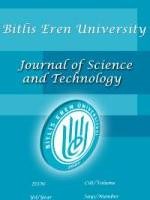Production and investigation of the mechanical properties of polypropylene-biosilica composites
Production and investigation of the mechanical properties of polypropylene-biosilica composites
Rice husk, Biosilica, Polypropylene, Tesnsile Test Flexural Test, Impact Test,
___
- Aprilia, S., Arifin, B., Nasrul, A., Amri, A., Wicaksono, A., & Bakhtiar, D. 2019. Synthesis and characterization film polypropylene/rice husk and rice husk ash nanocomposites. Rasāyan Journal of Chemistry, 12(2), 994–1001.
- Calignano, F., Lorusso, M., Roppolo, I., & Minetola, P. 2020. Investigation of the mechanical properties of a carbon fibre-reinforced nylon filament for 3D printing. Machines, 8(3), 52.
- Chandramohan, D., & Kumar, A. J. P. 2017. Experimental data on the properties of natural fiber particle reinforced polymer composite material. Data in Brief, 13, 460–468.
- Ezenkwa, O. E., Hassan, A., & Samsudin, S. A. 2022. Mechanical properties of rice husk and rice husk ash filled maleated polymers compatibilized polypropylene composites. Journal of Applied Polymer Science, 139(9), 51702.
- Fuad, M. A., Mustafah, J., Mansor, M., Ishak, Z. M., & Omar, A. M. 1995. Thermal properties of polypropylene/rice husk ash composites. Polymer International, 38(1), 33–43.
- Garcia, M., Van Vliet, G., Jain, S., Schrauwen, B., Sarkissov, A., Van Zyl, W., & Boukamp, B. 2004. Polypropylene/SiO 2 nanocomposites with improved mechanical properties. Reviews on Advanced Materials Science, 6(2), 169–175.
- Hardinnawirda, K., & SitiRabiatull, I. 2012. Effect of rice husks as filler in polymer matrix composites. Journal of Mechanical Engineering and Sciences, 2, 181–186.
- Herrmann, K. 2011. Hardness testing: Principles and applications. ASM international.
- Hindarso, H., Epriliati, I., Hoerudin, D., & Yuliani, S. 2021. Synthesis and Characterization of Biosilica from Rice Husks as a Catalyst for the Production of Biodiesel. Fine Chemical Engineering, 41–46.
- Huner, U. 2017. Comparisons of polypropylene composites: The effect of coupling agent on mechanical properties. Online J. Sci. Technol, 7, 28–40.
- Kenechi, N.-O., Linus, C., & Kayode, A. 2016. Utilization of rice husk as reinforcement in plastic composites fabrication—A review. American Journal of Materials Synthesis and Processing, 1(3), 32–36.
- Kohno, A., Techasrivichien, T., Suguimoto, S. P., Dahlui, M., Nik Farid, N. D., & Nakayama, T. 2020. Investigation of the key factors that influence the girls to enter into child marriage: A meta-synthesis of qualitative evidence. PloS One, 15(7).
- Kolawole, J. T., Babafemi, A. J., Fanijo, E., Paul, S. C., & Combrinck, R. (2021). State-of-the-art review on the use of sugarcane bagasse ash in cementitious materials. Cement and Concrete Composites, 118, 103975.
- Maulida, S. D., & Bukhory, F. 2018. ’The tensile strength properties effect of rice husk ash on the composite of plastic drinking bottle waste. International Journal of Scientific & Technology Research, 4(4), 66–69.
- Mirjalili, F., Chuah, L., & Salahi, E. 2014. Mechanical and morphological properties of polypropylene/nano α-Al2O3 composites. TheScientificWorldJournal, 2014, 718765–718765. PubMed (24688421). https://doi.org/10.1155/2014/718765
- Rahman, I. A., & Padavettan, V. 2012. Synthesis of silica nanoparticles by sol-gel: Size-dependent properties, surface modification, and applications in silica-polymer nanocomposites—A review. Journal of Nanomaterials, 2012.
- Rosa, S. M., Nachtigall, S., & Ferreira, C. A. 2009. Thermal and dynamic-mechanical characterization of rice-husk filled polypropylene composites. Macromolecular Research, 17(1), 8–13.
- Rufai, I., Uche, O., & Ogork, E. 2012. Biosilica from rice husk ash a new engineering raw material in Nigeria. 1–20.
- Sarangi, M., Bhattacharyya, S., & Behera, R. 2009. Effect of temperature on morphology and phase transformations of nano-crystalline silica obtained from rice husk. Phase Transitions, 82(5), 377–386.
- Sharma, P., Khanduja, D., & Sharma, S. 2014. Tribological and mechanical behavior of particulate aluminum matrix composites. Journal of Reinforced Plastics and Composites, 33(23), 2192–2202.
- Steven, S., Restiawaty, E., & Bindar, Y. 2021. Routes for energy and bio-silica production from rice husk: A comprehensive review and emerging prospect. Renewable and Sustainable Energy Reviews, 149, 111329.
- Subrahmanyam, A., Narsaraju, G., & Rao, B. S. 2015. Effect of rice husk ash and fly ash reinforcements on microstructure and mechanical properties of aluminium alloy (AlSi10Mg) matrix composites. International Journal of Advanced Science and Technology, 76, 1–8.
- Suddell, B. C., & Evans, W. J. 2005. Natural fiber composites in automotive applications. In Natural fibers, biopolymers, and biocomposites (pp. 253–282). CRC Press.
- Uribe, N. C., Echeverry, C. A., Betancur, M. V., Zapata, L. Y. J., & Martínez, J. 2018. Possibilities of rice husk ash to be used as reinforcing filler in polymer sector-a review. Revista UIS Ingenierías, 17(1), 127–142.
- Yang, H.-S., Kim, H.-J., Park, H.-J., Lee, B.-J., & Hwang, T.-S. 2007. Effect of compatibilizing agents on rice-husk flour reinforced polypropylene composites. Composite Structures, 77(1), 45–55.
- Yayın Aralığı: Yılda 2 Sayı
- Başlangıç: 2011
- Yayıncı: Bitlis Eren Üniversitesi
Sentiment analysis in social networks of health institutions
Production and investigation of the mechanical properties of polypropylene-biosilica composites
Solomon SUDİ, Richard Balthi MSHELİA
VIBRO-ACOUSTIC ASSESSMENT OF GRAIN GRINDING MACHINE FOR HEALTH RISK FACTORS ANALYSIS
